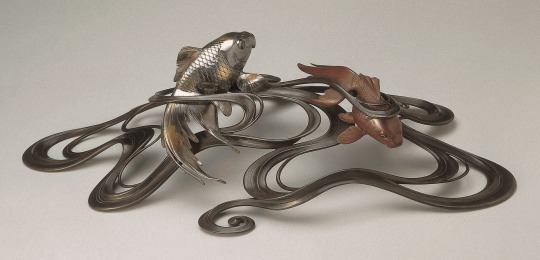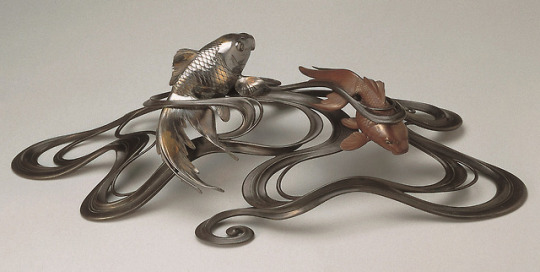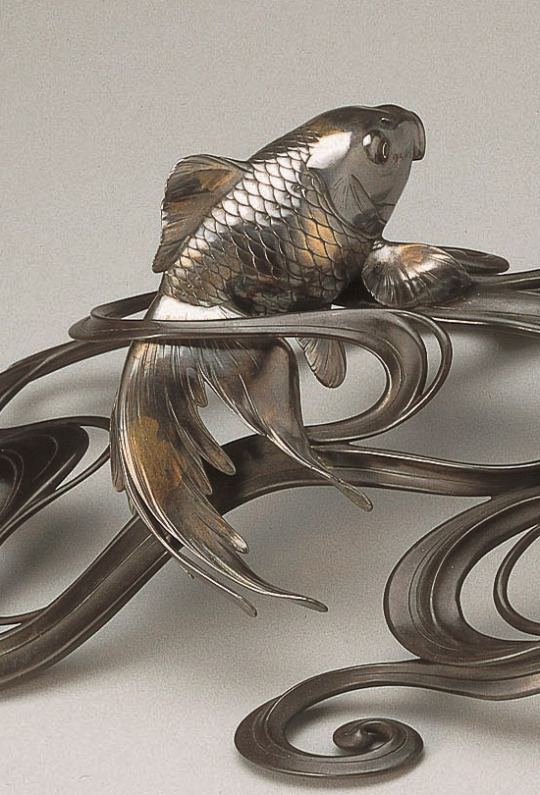#Oshima Joun
Explore tagged Tumblr posts
Text
Fabulous find for #FishyFriday:

Oshima Joun (Japanese, 1858-1940) Ornament of Fish in Waves (Okimono), c. 1900 bronze, silver, gilt, shibuichi and shakudo 13.1 x 48.7 cm Khalili Collections M159
"An okimono of stylized bronze waves among which swim two shubunkin, one cast in richly patinated copper, the other in oxidized silver with partially gilt areas, the eyes of shibuichi, shakudo, and gilt. The fish naturalistically modelled, supported by the highly stylized waves.
Oshima Joun (1858-1940), given name Yasutaro, was the son of the cast-metal worker Oshima Takajiro, whose father Yasubei had started the family business. He succeeded to the business in 1877 and took the name Joun. He used the go Shokaken.
He rapidly built up his business, and in 1879 had eleven assistants, selling mainly through Murakami Heishichi and a French client. Later he worked through the commissioner Honda. He first exhibited in Paris in 1878. In 1879 he was working with the Sanseisha Company of Tokyo, specifically on the great bronze figure of the Dragon King of the Sea, made for the Second National Industrial Exposition of 1881, that is so markedly similar to the figure M 17 in the Collection by Otake Norikuni (see Impey and Fairley, The Dragon King of the Sea, No. 11). He taught at the Tokyo Art School from 1887 until 1932.
A similar but slightly larger group of five carp was exhibited in the Paris Exposition of 1900, illustrated in the Fine Arts Magazine catalogue. Another similar silver group of carp was exhibited in the Japan-British Exhibition of 1910, illustrated on p. 184 of the English version of the catalogue, where it is listed under the name of the exhibitor Yezawa Kingoro, whereas in the (unpaginated) Japanese edition it is under the name of Oshima Joun. He was praised for his renditions of carp by Harada in ‘Metal-work’ p. 101.
O. Impey, M. Fairley (eds.), Meiji No Takara: Treasures Of Imperial Japan: Metalwork Vol II, London 1995, cat. 102. J. Earle, Splendors of Imperial Japan: Arts of the Meiji period from the Khalili Collection, London 2002, cat. 198, pp. 284–5."
#fish#metalwork#silver#bronze#okimono#Japanese art#East Asian art#Asian art#decorative arts#Oshima Joun#1900#19th century#20th century#Fishy Friday#Khalili Collections#animals in art
62 notes
·
View notes
Photo



Ornament of Fish in Waves (Okimono). Japan, circa 1900. Bronze, silver, gilt, shibuichi and shakudo. 13.1 x 48.7 cm. An okimono of stylized bronze waves among which swim two shubunkin, one cast in richly patinated copper, the other in oxidized silver with partially gilt areas, the eyes of shibuichi, shakudo, and gilt. The fish naturalistically modelled, supported by the highly stylized waves.
Oshima Joun (1858-1940), given name Yasutaro, was the son of the cast-metal worker Oshima Takajiro, whose father Yasubei had started the family business. He succeeded to the business in 1877 and took the name Joun. He used the go Shokaken. Text and image via Khalili Collection
8K notes
·
View notes
Text



Ornament of Fish in Waves (Okimono). Japan, circa 1900. Bronze, silver, gilt, shibuichi and shakudo. 13.1 x 48.7 cm. An okimono of stylized bronze waves among which swim two shubunkin, one cast in richly patinated copper, the other in oxidized silver with partially gilt areas, the eyes of shibuichi, shakudo, and gilt. The fish naturalistically modelled, supported by the highly stylized waves.
Oshima Joun (1858-1940), given name Yasutaro, was the son of the cast-metal worker Oshima Takajiro, whose father Yasubei had started the family business. He succeeded to the business in 1877 and took the name Joun. He used the go Shokaken.
17 notes
·
View notes

